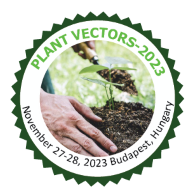Renowned Speakers

Mohammad Babadoost
Mohammad Babadoost received his Ph.D. in plant pathology from North Carolina State University.

Peggy Ozias-Akins
"Clonal reproduction through seeds - knowledge gains and gaps" University of Georgia

Andreas BORNER
Prof. Andreas Börner is working in the Leibniz Institute of Plant Genetics and Crop Plant Research, Corrensstr.

Amit MITRA
He has developed a convenient plant vector-transformation system based on Ti plasmid of Agrobacterium tumefaciens and electroporation

Dr. Goetz Hensel
Head Centre for Plant Genome Engineering Heinrich-Heine-University, Institute of Plant Biochemistry

Kan Wang
Kan Wang is a Chinese-American agronomistWang was elected a Fellow for her "advances in genetic engineering in plants using Agrobacterium tumefaciens."

Prof. Ian Godwin
He leads research in the use of biotechnological tools for crop improvement, with emphasis on the sustainable production of grain crops.

Robert KOEBNER
I was awarded a first class bachelor’s degree in Agricultural Science, majoring in plant breeding and genetics,
Recommended Global Agri, Food & Aqua Webinars & Conferences
Asia Pacific & Middle East
Plant Vectors-2023
About Conference
17th International Conference on Biofertilizers & Plant Vectors November 27-28, 2023 Budapest, Hungary
PLANT VECTORS-2023 contributes opportunities to Scientists, research scholars, students, delegates, and exhibitors to enhance their skills and improve quality of research. We welcome you to go along with us at the PLANT VECTORS-2023, where you will make certain to have an important involvement with both your colleagues and experts from around the globe. It helps you to implement practical, proven strategies to run your research more effectively, efficiently, and profitably.
The conference is going to be organized on the Theme: The best fertilizer for a piece of land is the footprints of its owner. This PLANT VECTORS-2023 goes to be the most important and most promising international conference that specifically focuses on the Biofertilizers & Plant vector by bringing all renowned researchers under one roof. This is often a 2-day multidisciplinary meeting covering all aspects of novel research and contributions within the field of Biofertilizers & Plant vector.
• Commendable talks by the first-string of the worldwide scientific community.
• Sterling workshop sessions.
• Global Recognition to meritorious Researchers.
• Global Networking with 50+ Countries.
• Novel Techniques to profit Your Research.
• Global Business and Networking Opportunities.
• Exquisite platform for exhibiting your by-products and International Sponsorship
Young Scientist Benefits
Our conferences provide best Platform for your research through oral presentations.
Share the ideas with both eminent researchers and mentors.
Young Scientist will get International Certificate.
Platform for collaboration among young researchers for better development
Target Audience
Research Scientist
Research Associates
Lecturer in an Educational institution
Why to attend?
Biofertilizers & Plant vector conference focus on creating an international platform for the participants to share their knowledge and research work on the respective fields. It will include various tracks and sub-tracks within the Biofertilizers & Plant vector field, which will further allow the participants to choose their respective tracks of their interests. The conference will give an opportunity to explore the topic with highly qualified researchers, scientists, Agricultural Scientist, professors and related people and associations who are involved in this field. It will be a great opportunity for the young researchers as well to learn and explore about their respective fields in Biofertilizers & Plant vector.
Scientific Sessions
Track 1: Biofertilizers
Bio fertilizers are substances containing living microorganisms that, when applied to seeds, plant surfaces, or soil, inhabit the rhizosphere or interior of plants and promote growth by increasing the supply or availability of key nutrients to the host plant. Bio fertilizers are considered a viable, sustainable and attractive biotechnology alternative for increasing crop yields, improving and restoring soil fertility, stimulating plant growth, reducing production costs and the environmental impacts associated with chemical fertilizers. Bio fertilizers are efficient microbial biologics that promote plant growth by improving nutrient acquisition. They improve soil productivity by fixing atmospheric nitrogen, dissolving soil phosphorus, and stimulating plant growth.
Track 2: Applications of Biofertilizers
Bio fertilizers produce hormones and antimetabolites that promote root growth. They help break down organic matter and mineralize the soil. When applied to seeds or soil, bio fertilizers increase nutrient availability and improve yields by 10-25% without adversely affecting the soil and the environment. They directly improve plant growth by producing plant growth regulators such as auxins, gibberellins and cytokinins. Induction of root metabolic activity and supply of biologically fixed nitrogen. As a result, germination, root development, nutrient and water absorption are improved. Without fertilizers, nature struggles to replenish soil nutrients. When crops are harvested, important nutrients are removed from the soil. If the soil is not replenished with nutrients through fertilizer, crop yields will decrease over time.
Track 3: Production of Biofertilizers
Bio fertilizer production is inherently dependent on the availability and isolation of target microorganisms in specific environments, including rhizosphere and plant tissue. Candidate microorganisms are cultured and multiplied using fermenters under optimal growth conditions. The main sources of Bio fertilizers include bacteria, cyanobacteria and fungi.
- Large-scale production of bio fertilizers
- Preparation of Broth Culture
- Carrie's Preparation
- Inoculation preparation i.e. mixing
- Hardening or maturation
- Filling and packaging
- Quality inspection
- Store
Track 4: Sustainable agriculture
“Sustainable agriculture” means an integrated system of plant and animal production practices that can be applied in a specific place in the long term, such as: It meets human food and fiber needs. Sustainable agriculture fosters healthy ecosystems and supports sustainable management of land, water and natural resources while ensuring global food security. Production of enough human food, feed, fiber and fuel to meet the needs of a rapidly growing population. Protecting the environment and expanding the supply of natural resources. Maintaining the economic viability of the agricultural systems. By adopting sustainable practices, farmers will reduce their dependence on non-renewable energy, reduce their use of chemicals and conserve scarce resources. Keeping the land healthy and replenishing it can go a long way when you consider growing populations and food needs.
Track 5: Nitrogen fixers
Nitrogen fixation, any natural or artificial process that causes free nitrogen (N2), which is a relatively inert gas generous in air, to combine chemically with other elements to form more- reactive nitrogen composites similar as ammonia, nitrates, or nitrites. Under ordinary conditions, nitrogen doesn't react with other rudiments. Yet nitrogenous composites are set up in all fertile soils, in all living effects, in numerous foodstuffs, in coal, and in similar naturally being chemicals as sodium nitrate and ammonia. Nitrogen is also set up in the nucleus of every living cell as one of the chemical factors of DNA. Nitrogen is fixed, or combined, in nature as nitric oxide by lightning and ultraviolet rays, but more significant quantities of nitrogen are fixed as ammonia, nitrites, and nitrates by soil microorganisms. further than 90 percent of all nitrogen obsession is effected by them.
Track 6: Phosphorus solubilizes
Phosphorus (P) is a macronutrient needed for the proper functioning of plants. Because Phosphorus plays a vital part in every aspect of plant growth and development, scarcities can reduce plant growth and development. Though soil possesses total Phosphorus in the form of organic and inorganic composites, utmost of them remain inactive and therefore unapproachable to plants. Since numerous farmers cannot go to use Phosphorus diseases to reduce Phosphorus poverties, indispensable ways to give Phosphorus are demanded. Phosphate solubilizing microbes (PSMs) are a group of salutary microorganisms able of hydrolyzing organic and inorganic undoable phosphorus composites to answerable Phosphorus form that can fluently be assimilated by plants. PSM provides an ecofriendly and economically sound approach to overcome the Phosphorus failure and its posterior uptake by plants. Though PSMs have been a subject of exploration for decades, manipulation of PSMs for making use of adding fixed Phosphorus in the soil and perfecting crop product at the field position has not yet been adequately capitalized . The purpose of this review is to widen the understanding of the part of PSMs in crop product as Biofertilizers.
Track 7: Plant cloning vector
A cloning vector is a small piece of DNA that can be stably maintained in an organism, and into which a foreign DNA scrap can be inserted for cloning purposes. The cloning vector may be DNA taken from a virus, the cell of a advanced organism, or it may be the plasmid of a bacterium. The vector contains features that allow for the accessible insertion of a DNA scrap into the vector or its removal from the vector, for example through the presence of restriction spots. The vector and the foreign DNA may be treated with a restriction enzyme that cuts the DNA, and DNA fractions therefore generated contain either deaden ends or protuberances known as sticky ends, and vector DNA and foreign DNA with compatible ends can also be joined together by molecular ligation. After a DNA scrap has been reproduced into a cloning vector, it may be further subcloned into another vector designed for more specific use.
Track 8: Aphids
Aphid,( family Aphididae), also called plant louse, greenfly, or ant cow, any of a group of sap- stinking, soft- bodied insects( order Homoptera) that are about the size of a pinhead, utmost species of which have a brace of tube like protrusions( cornicles) on the tummy. Aphids can be serious plant pests and may stunt plant growth, produce plant galls, transmit plant contagion conditions, and beget the distortion of leaves, buds, and flowers. Aphids are small, soft- bodied insects with long slender mouthparts that they use to pierce stems, leaves, and other tender plant corridor and suck out fluids. nearly every plant has one or further aphid species that sometimes feed on it. numerous aphid species are delicate to distinguish from one another; still, operation of utmost aphid species is analogous. Generally adult aphids are wingless, but utmost species also do in winged forms, especially when populations are high or during spring and fall. The capability to produce soared individualities provides the pest with a way to disperse to other plants when the quality of the food source deteriorates.
Track 9: Plant viral vectors
Plant viral vectors delivered by Agrobacterium are one of several manufacturing processes presently in use to produce a wide range of proteins for a variety of operations, including vaccine antigens, antibodies, protein nanoparticles similar as contagion- suchlike patches( VLPs), and other proteins. Aphids are the most common vectors of plant viruses. utmost plant contagions that beget complaint in agrarian crops calculate on biological vectors for transmission and survival. The largest class of plant virus transmission vectors is insects, but other vectors include diminutives, nematodes, and chytrid fungi.
Track 10: Applications of plant vectors
Applications of virus-based vectors include specific studies of plant biochemical processes, including production of human/animal therapeutic proteins in plant cells and conferring resistance to pathogens. Insect vectors play an important role in determining the plant host range of viruses. Viral transmission capacity is determined by genetic components and specific molecular interactions of viruses and vectors, potentially with host plant components absorbed during feeding. A vector is a DNA molecule (often a plasmid or virus) that is used as a means of transporting a specific DNA segment into a host cell as part of a cloning or recombinant DNA technique in the context of molecular biology.
Track 11: Cosmids
A Cosmids vector is a hybrid between a plasmid and a phage λ vector. A classic example of a Cosmids vector is c2RB, which has an origin of replication and a cloning site and carries an antibiotic resistance gene. Like phage λ vectors, Cosmids vectors encode the cos sequence required to package DNA into a λ capsid. A Cosmids is a type of hybrid plasmid that contains the lambda phage cos sequence. They are often used as cloning vectors in genetic engineering. Cosmids vectors are developed by combining features of plasmid vectors and bacteriophage vectors. The origin of replication, multiple cloning sites and selectable markers are obtained from the plasmid and only the aggregation site or cos site region is taken from the lambda phage.
Track 12: plant RNA viruses
Plant RNA Viruses Molecular Pathogenesis and operation provides wide- ranging content on the recognition and signaling events between plants and RNA viruses. The book examines the molecular biology of signaling, host- virus commerce, RNA virus diversity, and how plants and cellular pathogens interact. Sections cover Virus Diversity and opinion, Virus- Host relations and Virus Management. Specific chapters bandy bracket and nomenclature of viruses, detail the molecular characteristics of viral genomes, punctuate the viral manipulation of cellular crucial nonsupervisory systems for successful virus infection, and bandy the movement of plant viruses into plant cells. Fresh motifs include RNA plant viruses and host commerce, discovery and diversity of plant RNA contagions, and strategies for combating and operation of plant viruses. With benefactions from a transnational group of experts, the book is a comprehensive reference for those in exploration, academia, assiduity and anybody engaging in the study of plant viruses at the molecular position.
Track 13: plant DNA viruses
DNA viruses contain DNA as their inheritable material. DNA viruses infecting plants are classified into two groups according to the Baltimore classification of viruses single- stranded (ssDNA) DNA viruses (e.g., Geminiviruses) and double- stranded DNA viruses (e.g., Caulimoviruses). There are smaller plant DNA viruses, but they beget a significant number of ruinous conditions in multitudinous crops worldwide and oppressively reduce the crop yield. Plant DNA viruses are especially rare as compared with animal and bacterial DNA viruses. This chapter focuses on the biochemistry, replication and molecular genetics of plant DNA viruses. The ssDNA plant viruses are small, render many proteins, and depend substantially on the host factor for their replication. Geminiviruses, a recently discovered group of plant viruses, have single- stranded indirect DNA in their genome.
Track 14: Plant expression vectors
Creative Bio gene is an expert in plant inheritable engineering and molecular biology. We've devoted numerous times of efforts in optimizing plant expression vectors to acclimatize to different plant species. We give universal and tailored plant expression vector construction services, covering from sequence optimization, gene conflation/ cloning, DNA scrap assembling, sequencing to plasmid medication. With advanced technologies and largely educated staffs, we will work nearly with you to bring satisfied plant expression vector construction services. Gene cloning and vector construction are routine procedures in plant inheritable engineering. The vacuity of effective metamorphosis vector is one of the pre-requisites for plant metamorphosis studies. The generation of genetically modified crops with valued traits requires different combinations of expression rudiments to achieve optimum goods. In addition, a right choice of expression construct also plays an important part in exploration of gene function and protagonist exertion analysis.
Track 15: Ti Plasmids
The Tumor inducing or Ti plasmid is present in the bacterium Agrobacterium tumefaciens. It's extensively used now as a cloning vector to deliver desirable genes to the host plant to get transgenic plants. A tumour converting plasmid is a plasmid set up in pathogenic species of Agrobacterium, including A. tumefaciens, A. rhizogenes, A. rubi and A. vitis. Evolutionarily, the Ti plasmid is part of a family of plasmids carried by numerous species of Alpha proteome bacterial. Ti plasmids carry genes for elaboration of two DNA conjugation systems, one( Tra/ Trb) responsible for conjugative transfer of the Ti plasmid and the alternate( VirB/ VirD4) devoted to the delivery of a segment of the Ti plasmid called the T- DNA as well as several effector proteins to plant cells during the infection.
Market Analysis
The global biofertilizers market size was valued at USD 1.0 billion in 2019 and is anticipated to witness a compound annual growth rate (CAGR) of 12.8% from 2020 to 2027. The increasing usage of microbes in biofertilizers proves the potential for sustainable farming methods and food safety. The increasing concern with respect to food safety is expected to drive the market for biofertilizers over the forecast period.
The global agriculture industry is a fast-moving sector with dynamic changes on various levels across all economies of the world. With intervention of digital farming and precision farming practices prevailing in all countries, the growing economic regions are adapting to technological reforms to sustain in the ecosystem. Technological adaptability comes with high investments, which in turn, affects the overall return on investments. This is a key factor that puts an entry barrier to small agricultural entrepreneurs and medium-scale farmers to penetrate in the global competitive environment
During the last couple of decades, organic farming has reached acceptance among policymakers, farming communities, market actors, and customers globally. As of 2017, it was noted that more than 70 million hectares of agricultural land across the globe was utilized for organic farming practices, which accounts for over 1.4% of the overall farming area worldwide. With this trend in place, the availability of farmland for organic farming in the U.S., Australia, and Argentina, among other nations, has compelled various agencies and governments to frame supportive policies to increase the production output of organic foods. Currently, it is observed that the European Union nations and the U.S. are the largest organic farming communities globally followed by China among other Asia Pacific countries.
Abstract Submission Criteria And Eligibility
Abstract Submission Criteria and Eligibility
PRESENTATION REQUIREMENTS:
Participating authors are answerable for registration, travel, and hotel costs. Note: Those with submitted abstracts will get an acknowledgment mail enabling them to enroll for the gathering.
Abstracts will be compiled, and conference books are made available to participants at the conference.
Any presenter who is unable to attend should arrange for another qualified individual to present the paper/poster in question. If such a change is necessary, please notify our conference team.
SUBMISSION OPTIONS:
Oral paper introductions will have 30-minute schedule time slot. The keynote session will have for 45-minute presentation duration, workshop/special session will have 1-hour long schedule opening and symposium will have 1-hour long availability followed by 5-minute Q&A session.
Graduate and master’s understudies are qualified to present their abstracts under poster and e-poster presentation category.
Ph.D. understudies are qualified to submit their abstract under special YRF (Young Researcher's Forum), poster and e-poster presentation category.
NOTE: YRF category includes short oral presentation especially for Ph. D. students
Extended abstract: Submissions should utilize the Abstract Template. Papers submitted in this category may represent original empirical research, theoretical development, reviews, or critiques.
Participation Options and Benefits
PARTICIPATION OPTIONS: Biofertilizers & Plant Vectors Conference provides the participants with different modes or ways to participate such as Delegate or Speaker under ACADEMIC / STUDENT / BUSINESS Category. Mode of participation is Online through Power Point Presentation/ Video Presentation on Cisco Webinars.
1. Keynote speaker: 45-50 minutes
2. Speaker (oral presentation): 25-30 minutes (only one person can present)
3. Speaker (workshop): 45-50 minutes (more than 1 can present)
4. Speaker (special session): 45-50 minutes (more than 1 can present)
5. Speaker (symposium): more than 45 minutes (more than 1 can present)
6. Delegate (only registration): will have access to all the sessions with all the benefits of registration
7. Poster presenter: can present a poster and enjoy the benefits of delegate
8. Remote attendance: can participate via video presentation or e-poster presentation
9. Exhibitor: can exhibit his/her company’s products by booking exhibitor booths of different sizes
10. Media partner
11. Sponsor
12. Collaborator
Benefits of Joining Conference:
Get your abstract published with DOI
Get Certified for your participation
Reduced Costs Affordability
Knock Down Geographical Barriers
Convenience from comfort of your own home or from work
They’re Archived: Ability to view events in the recording
Great resource for learning new career skills
Learn from the Pros
Global exposure to your research
Make new connections
Significant time saving
Increased engagement
Wider Reach
More Engaging
Position yourself as the expert
Get your abstracts published with unique DOI in International Journals
Get up to 50% discounts for publishing your entire article in our open access International Journals
Get Handbooks and conference kits
Get an access to the network with eminent personalities from worldwide.
To Collaborate Scientific Professionals around the World
Conference Date November 27-28, 2023
For Sponsors & Exhibitors
Speaker Opportunity
Useful Links
Past Conference Report
Supported By
All accepted abstracts will be published in respective Conference Series International Journals.
Abstracts will be provided with Digital Object Identifier by






